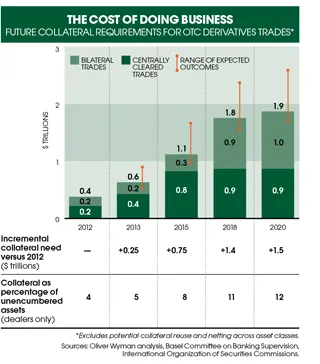Amid fears that new rules for the over-the-counter derivatives market will trigger a collateral shortage, banks see rich revenue opportunities in a once-dull corner of the custody business. As pension funds, insurance companies and asset managers prepare to move to central clearing for OTC derivatives trades, collateral management experts are their new best friends. “Collateral management professionals used to be in the subterranean basement of a bank’s operations,” says Nadine Chakar, New York–based head of product and strategy for global collateral services at Bank of New York Mellon Corp. “Now all of that has changed, and they are like rock stars.”
Collateral management involves helping firms handle the securities they’re owed or that regulators want them to post with central counterparties as initial margin on derivatives transactions. As insurance against default, clearinghouses demand highly rated liquid instruments such as U.S. Treasuries and U.K. government bonds, or gilts.
The Commodity Futures Trading Commission requires most U.S. insurers to start using central clearing on June 10; U.S. pension funds and asset managers must follow in early September. Similar regulations take effect next year in Europe. Big hedge funds have had to use central clearing for OTC derivatives since March, but until now pension funds and insurers haven’t needed to post collateral on derivatives arranged bilaterally with dealers.

An April report by Morgan Stanley and consulting firm Oliver Wyman estimates that the shift to central clearing could knock between $5 billion and $10 billion off global bank revenue by 2015. Two main contributors will be the cost of creating new infrastructure and moving clients to listed derivatives. In addition, dealers and clients may need to post $1.4 trillion more collateral by 2018 than the $400 billion required last year, Morgan Stanley and Oliver Wyman forecast. The report says the new rules will probably drive up the cost of collateral and produce a surge in demand for Treasuries.
Some investors may opt to avoid derivatives by instead using listed futures, a market without such steep collateral demands. But that isn’t always the best option: Investors use OTC derivatives because they can be tailored to hedge against long-term liabilities that often exceed 30 years. Futures contracts are standardized and must be refinanced every three months.
Since March 2012 the Chicago Mercantile Exchange has let dealers use as much as $5 billion worth of corporate bonds as eligible collateral, a move that makes a crunch less likely. The CME requires that such bonds have a minimum A-minus rating from at least two of the major agencies: Fitch Ratings, Moody’s Investors Service and Standard & Poor’s.
For banks the new rules promise to usher in a lucrative new business known as collateral transformation, whereby an investor pledges collateral in exchange for a loan of Treasuries. The investor then posts the “transformed” Treasuries to the clearinghouse as initial margin.
“We do not feel the collateral crunch will be as significant as some predict, if limited to initial margin only,” says Ray Kahn, head of OTC clearing at Barclays Capital in New York.
Collateral transformation has raised fears that swapping assets rated triple-B or below for cash or double-A-plus-rated Treasuries will increase systemic risk. Those worries are unfounded, BNY Mellon’s Chakar contends. “Collateral transformation is not about swapping poor-quality assets for better ones,” she says. “It’s about exchanging high-quality ineligible collateral for high-quality eligible collateral. Banks won’t be reckless with this.”
Collateral transformation will be one of several business lines that banks develop to generate about $7 billion in revenue from end users of derivatives by 2018, the Morgan Stanley–Oliver Wyman report predicts. Kelly Mathieson, New York–based global head of collateral management at JPMorgan Chase & Co., recommends that clients secure the right collateral as early as possible to avoid high transformation costs. “What’s more important is for collateral agents to provide analytics that enable a client to see what collateral will be needed long before a trade is due for settlement,” she says.





